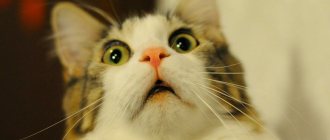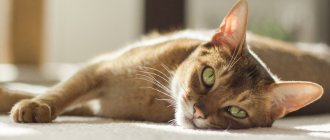Most known breeds of domestic cats are of foreign origin. But in our country there is a luxurious representative, of whom Russian felinologists are very proud. This is a Russian Blue cat - elegant, with the graceful grace of a ballerina, sophisticated appearance and self-sufficient character. A real beauty with many advantages!
Russian blue cats are popular all over the world. They are in great demand in the European Union, Great Britain and the CIS. The British call this breed Blue Archangels. Plush cats with magnificent fur coats reached Britain back in the 19th century and quickly won the hearts of noble people. Today we will talk about this amazing domestic cat, which attracts not only its stunning appearance, but also its aristocratic demeanor!
History of the breed
According to historical sources, cats with dark blue dense fur lived in the Arkhangelsk province. The famous Tsar of All Rus' Peter I had a favorite cat Vaska, who traveled around the palace without any restrictions. Blue cats were the king's true passion, and this love for elegant representatives was adopted by his daughter Elizabeth.
Excellent cats with beautiful fur coats would have existed on their own if the famous breeder Carews-Cox had not paid attention to them. In 1893, she took a couple of females and one male for breeding. The animals were brought to Britain and there they began to actively reproduce through selective breeding.
During World War II, there was a threat to the existence of Russian blue cats, but already in the post-war period, breeders again began actively breeding the breed.
Photos of Russian Blue cat kittens
A remarkable fact: Russian Blue cats became popular in Russia only in the late 80s.
Today, these magnificent representatives have retained their original qualities and amazing appearance, according to generally accepted standards, finally approved in the second half of the 20th century.
Appearance Features
The gracefulness and elegance of the breed makes its representatives one of the most beautiful smooth-haired cats. According to the standard, the body should be of medium size and have an elegant appearance.
Features of the body and head:
- the body should be slightly elongated;
- the neck is straight and long;
- the long tail should taper towards the tip;
- paws should be tall and slender;
- the skull is elongated and should have a narrow shape;
- the head should have a slightly flat shape;
- ears should stand upright, they should be pointed;
- the eyes are oval or almond shaped and should be set wide apart;
- eye color – rich green without impurities or inclusions.
The main pride of the breed is its wool. It has a very noble appearance due to its pure blue color with a silver tint, thickness and silkiness. The soft texture of the wool gives it a plush feel.
The guard hair is approximately identical in length to the undercoat, giving the appearance of a very thick coat. Occasionally, young kittens may have slight tabby stripes, but these should disappear as they age.
Standards vary slightly from country to country. There are several different types of standard recorded:
- Russian
- European;
- Scandinavian;
- American.
Differences may be observed:
- in physique;
- during the period of eye coloring;
- in the structure of the skeleton;
- in shade of color.
The furthest thing from the classic description of the breed is the American standard. It assumes a smaller cat, but the body should be longer than in other standards.
The color shade is supposed to be the lightest, the eyes should be larger, and the ears should be set at a greater distance.
Description and characteristics of the breed
Russian Blue cats have a graceful physique, an elegant gait and a graceful figure. Life expectancy with proper feeding and care is 15-20 years. The average weight of an adult cat is 3-4 kg, a male cat is 4-6 kg.
Character and manners
Affectionate cats with a quiet and pleasant voice have a loyal character and well-developed intelligence.
This pet will not follow on the heels of its owner, and from the first days the cat will never show its love and affection. You need to earn it with your attention and care! But, having earned the trust of this handsome representative, you will find a truly reliable friend and unobtrusive companion, ready to support his owner at any difficult moment.
An intelligent cat is wary of strangers and does not make contact with the first person he meets. When guests arrive in the house, he tries to retire and not be seen. But it’s only in appearance that the pet is hiding; in fact, it sits in a secluded place and carefully watches what is happening from the side.
Russian Blue cats are agile and brave, they love heights, so they often climb to the highest shelves in the house.
They learn quickly and understand the owner's commands. This cat knows the word “no” well and always tries to be well-mannered and intelligent. There are usually no problems raising cats of this breed.
And a few more qualities characterized by Russian Blue cats:
- love independence and freedom, often walk on their own;
- they value order in everything, so they are often picky about an unwashed tray or empty bowl;
- do not like noise in the house, prefer to live in a quiet environment;
- become attached to home and have a hard time moving;
- have a well-developed hunter's instinct, love to catch birds and rodents;
- kittens are active and playful; they often choose various toys and rustling objects for entertainment.
Russian blue kitten 2 months (photo)
Breed characteristics (appearance standard)
- graceful, well-proportioned body of small size;
- long legs with rounded pads;
- the tail is long with a rounded tip;
- the neck is long, but due to the thick hair on the collar it seems short;
- a medium-sized head with a pronounced chin and slightly convex mustache pads;
- a small nose without kinks with a gray-blue tip;
- expressive oval green eyes;
- large, widely set ears, slightly pointed at the tip;
- silky soft coat with long undercoat.
Character
There were legends about the character of the Arkhangelsk favorite among the people. This naturally occurring cat almost never made a sound. The cat in heat and the walking cat did not scream or mark territory in the house. The dangerous period could be determined rather by the animal’s excessive affection. The rest of the time, these royal animals remained calm and equanimous, sparingly demonstrating their love for their owner. But there is no phlegmaticity or arrogance in the temperament of these animals.
They are strongly attached to their owner. They always try to keep their “ward” in sight. Possessing excellent resistance to stress, they tolerate changes quite well - departures of family members, the appearance of other pets in the house.
If there are noisy children in the house, they will become their nannies and playmates. But the claws will never come out, even if the child accidentally caused pain. But with real offenders they can confidently stand up for themselves. There are known cases when, protecting offspring, the Arkhangelsk cat successfully dispersed a pack of dogs.
The middle-aged owner will enjoy sitting next to him on long evenings, listening carefully and assenting. Absolutely not vindictive. And, even if they were scolded, they will make a dissatisfied appearance and disappear from view for some time only to return with a royal bearing as if nothing had happened a few minutes later.
Since ancient times, they have been valued by Russian people as excellent hunters. Arkhangelsk had no equal in exterminating rats and mice in the yard and house. Today, the Russian Blue demonstrates its habits in any conditions - it will never lose interest in a butterfly, fly or bird, and will keep its eye on the object for hours until it captures the prey with one precise throw.
This cat is very smart, easy to educate and even train. The necessary skills should be instilled from early childhood. Then in a city apartment there will be no problems with the pet’s scratching post and toilet.
Nutrition, maintenance and care of the Russian Blue
Like any other purebred representative, Russian Blue cats need proper care and, of course, high-quality nutrition!
You need to take care of your cat from the first days of its stay in your home. As we have already said, kittens are wary of strangers and take a long time to adapt to a new place. The owner needs to show patience and care, which will build trust in the furry representative.
Experts recommend creating a separate place in the house for the Russian Blue, where she can retire and spend time peacefully at any time of the day.
You will also need a cat litter box, a bowl for water and food, accessories for brushing, bathing and other grooming procedures.
All these items can be purchased at a specialized pet store and veterinary pharmacy. Experienced sellers will recommend the necessary equipment for a comfortable life for a new family member in your home!
What can you feed
Small Russian Blue kittens need to be fed five times a day. As they grow older, the number of feedings decreases and by the first year of life two meals a day are established.
When buying a pet from a breeder, ask what food the kitten is accustomed to.
If your baby was fed premium ready-made industrial food from an early age, keep his usual diet.
If the owner plans to feed a cat of this breed with natural products, it should be introduced to such a diet gradually.
Expert recommendations:
- Provide your cat with a balanced diet of natural products;
- Most of the daily menu should be lean meat;
- several times a week you can give your cat offal, chicken eggs, fermented milk products, vegetables, cereal porridge, boneless lean sea fish;
- the list of prohibited foods includes fatty meats and fish, sweets, baked goods, spicy, salty, smoked and fried foods;
- you cannot feed a purebred cat with food from your table;
- dishes for feeding your pet are prepared separately without salt, pepper and other spices;
- Clean drinking water should always be freely available;
- After feeding, remove any remaining food from the bowl and clean the dishes.
Flaws
- If the owners do not take care in time to purchase a scratching post that is correctly selected for the height of the animal, then their wallpaper may be torn .
- Pets love to sleep next to their owners.
- Some representatives of the breed are very talkative , they like to purr next to their owners, but they do it quietly.
- They cannot stand moving , they are strongly attached to their home, and their new habitat can cause a negative reaction.
- They do not like guests, they are very afraid of strangers, they hide from them.
- They are always close to the owners, they need to know everything that is happening in the house.
- They may start hunting for pet parrots that have flown out of their cages.
Names for girls cats
If a lovely girl of the Russian Blue breed appears in your home, you need to come up with a beautiful name for her that matches her character and appearance. Don’t rush to choose a nickname, take a closer look at the kitten and soon you will understand what is best for your baby. Well, we’ll give you a few options to think about!
Names for boys cats
Names from this list are perfect for Russian Blue cats:
Adams, Albert, Armani, Alan, Achilles, Baloo, Leopard, Bonnie, Best, Wulf, Viking, Gucci, Garfi, Danila, Diego, Dymok, Eroshka, Jacques, Zeus, Zulan, Invar, Indigo, Cliff, Queen, Candy, Congo, King, Lucky, Leopold, Mars, Moor, Maurice, Muscat, Nemo, Noris, Olympus, Odysseus, Patrick, Prince, Punch, Rocko, Raphael, Raymond, Spotty, Simon, Strike, Toby, Timati, Hurricane, Ursik, Fidel, Focus, Frost, Freddy, Harley, Khan, Chucky, Genghis Khan, Chubik, Storm, Shandy, Sheikh, Esmir, Andy, Ashley, Yuks, Yashka, Yasson.
If you can't decide on a name and you really like several options, try asking your cat what name he likes. Call the selected nicknames one by one and watch the cat’s reaction. Which name will he best respond to, choose it!
Catteries of Russian Blue cats in Russia
There are a lot of nurseries in Russia where you can buy a purebred Russian Blue kitten for home keeping and for exhibitions. Breeders will offer a choice of kittens with measurements and pedigree, which will allow you to represent your furry friend at various animal events.
Kennels of this breed in Russia:
- Kennel Perfect Cat Moscow
- SHEER LOVE CATTERY Krasnodar
- BEST BEAST St. Petersburg
- Nizhegorodskoe Serebro Nizhny Novgorod
- LV* Fantasy RUSsia Kaliningrad
- Legenda Rusy Vladimir
- Nursery Shleif Bay
- Northern Star St. Petersburg
- Blue Grace Moscow
- Nursery Rosalia
At what price can you buy a kitten?
A young individual with the appropriate documents can be purchased within the price range from 150 to 800 dollars. The price is affected by the class and health of the animal. Most often, females have a higher price than males. See also all photos and names of breeds - purebred cats.
Popular kennels for this breed:
- Russia - (your nursery is here);
- Belarus - (take place);
- Ukraine - (submit an application).
How much do Russian Blue cat kittens cost?
The price of a Russian Blue kitten is ambiguous and depends on various factors:
- A vaccinated cat with a veterinary passport for home care costs 5-15 thousand rubles. These representatives are classified as “pet” (not suitable for exhibitions).
- Kittens with pedigree and metrics for breeding (Brit category) cost 17-25 thousand (price in rubles). The breeder will also fill out a veterinary passport for the cat indicating vaccinations and parasitic treatment.
- The most expensive kittens of the Russian Blue breed from the Show category, suitable for exhibitions and having all the necessary documents, are sold at a price of 25,000 rubles or more.
Seals of this breed are sold in specialized nurseries. If you want to buy a kitten from private owners, look for a responsible seller with a good reputation and positive reviews.
Cons of this breed
The Russian Blue cat is an intelligent cat with a wayward character. She has a beautiful appearance and decent manners, but there are also some disadvantages of the breed, based on reviews from breeders and owners:
- takes a long time to adapt to a new home;
- does not acknowledge guests;
- has an independent character and often shows a love of freedom;
- does not tolerate noise, loves peace and quiet;
- needs a secluded corner where she will always be calm and comfortable;
- picky, loves cleanliness and basically does not eat from a dirty bowl;
- hunting habits strongly predominate, so it can pose a threat to small rodents and birds living in cages.
Health
Characteristic diseases
Russian Blues, like Norwegian Forest Cats and Egyptian Mau , were not bred artificially. They belong to natural breeds.
Therefore, they have strong immunity and good health. They live a long time and very rarely get sick.
Russian Blues are not afraid of drafts and cold temperatures. They do not have any genetic breed diseases.
Although they, like other felines, can suffer from diseases typical of cats.
Vaccinations
For the first eight weeks, kittens are protected by maternal immunity. Then the kittens are vaccinated .
Only healthy animals can be vaccinated.
Suitable age is 2.5–3.5 months. For this purpose, combined vaccines against rhinotracheitis, panleukopenia, and calcivirus are used.
Vaccination takes place in several stages. Interval – 3–4 weeks.
Before vaccination, kittens are given anti-worm medications.
Russian Blue is one of the most hassle-free cats to own.
After a month has passed from the date of the last comprehensive vaccination, kittens are vaccinated, like dogs, against ringworm .
The rabies vaccine is given at 3–4 months of age. It must be repeated annually.
Reviews from owners and breeders
We have already talked about the shortcomings of the breed according to the owners’ reviews, but now let’s see what positive qualities characterize Russian blue cats:
- beautiful, smart, with good manners;
- playful, affectionate with owners;
- has self-esteem;
- loyal and clean;
- kind and interesting;
- low maintenance;
- excellent hunting abilities;
- the ability to show your best side.
Reviews from allergy sufferers: the cat practically does not shed, and its fur does not cause allergic reactions and is considered hypoallergenic.
Keeping a pet
Russian blue cats are animals with good health. They do not have genetic diseases. Of course, any cat can get a common cat disease, so it is very important not to violate the conditions of keeping the pet. Blue cats do not like closed spaces, so do not leave your pet in a locked room.
Many people I know lock their cat in a separate room when they are cutting meat in the kitchen. After all, the cat may start begging for it, and the owner may not resist. And I allow my cat to come into the kitchen at any time. Of course, she loves any meat and will lick her lips at the sight of it, but she will not climb onto the table and steal it. I allow the cat to sit at the table (on a chair) and just watch. And for good behavior after cooking, I can give you a treat. If she is accidentally locked out, she gets offended.
You can buy or make a play set for your cat yourself. The animal should have a separate place for rest and entertainment. The complex must have a house (the cat can hide there from annoying children). You also need a soft bed for sleeping. All cats love to climb to different heights and sharpen their claws, so slats, ladders and scratching posts are also desirable.
Video: Russian Blue cat named Luna
Nutrition
A cat's diet must maintain a balance of nutrients. If you decide that you will feed your cat with store-bought food, then try to choose the best types. The food must contain proteins, fats, carbohydrates, vitamins and minerals. Read the ingredients carefully. The product must not contain iodine or copper. These microelements can make a cat's fur appear yellowish. When feeding store-bought food, it is important to remember that the daily diet should consist of 3/4 dry food and 1/4 wet food.
It is not recommended to combine homemade food with store-bought food. Firstly, it is difficult for a cat to switch from one type of food to another. This can affect the health of the digestive system. And secondly, if a cat’s fur becomes dull or diarrhea begins, you will not be able to understand which food she has such a reaction to.
Problems with wool can also arise with natural nutrition. The silver-blue coat may turn brown due to eating too many legumes or liver. This pet should not be given whole milk. A fatty product will also affect your health. Moreover, adult cats generally do not tolerate milk well. Instead, you can offer her fermented milk products (kefir, fermented baked milk, lean sour cream). It is not recommended to feed your cat fatty fish and other seafood. All cats love the smell and taste of fish, but it must be given correctly. The fish should be boiled, unsalted, and there should be little of it. From excessive consumption of fish, cats can develop urolithiasis (especially in male cats). But you can still include it in your diet, since it contains omega-3 and omega-6 fatty acids (good for the heart).
I buy trout or herring for my cat. I boil the required amount in unsalted water (trout steak or half a fish of herring). When it cools down, I separate it from the bones (if you cook for more than 30 minutes, the bones come off on their own) and divide into portions. I get 3 servings (1 tablespoon is a serving). I pack the pieces into processed cheese boxes and freeze them. I defrost it before feeding it - once a week.
Not only its appearance, but also its health depends on proper nutrition of a cat.
In addition, blue cats can be fed lean meat (chicken, turkey or beef). If possible, you can grow cat grass (such as oats). In addition to vitamins, it contains a lot of fiber. This herb is useful for cats, as it helps remove hair from the body. Arkhangelsk cats love to eat. Therefore, it is important to control the amount of food you eat. It is best to feed your pet 2 times a day (adults, but kittens can do it more often). One of the features of the breed is remembering the routine. The cat will definitely remember what time of day it is given food.
Appearance care
Short, soft hair allows Russian cats to take care of their hygiene independently. This is especially true for fur - the pet is able to lick it. But to prevent the wool from getting into the gastrointestinal tract, the animal needs help. A natural bristle brush is suitable for this. The Russian cat sheds twice a year: in spring and autumn. During the shedding period, you need to comb out the undercoat. Moreover, first comb the cat against the fur, and then in the direction of its growth. After the procedure, you can wipe the cat with a flannel cloth or a special mitten. The animal will be grateful for combing. When the cat does not shed, you can brush it once a week.
Russian Blue cats don't really like water. Therefore, your pet does not need to be bathed often (you can not bathe it at all). Periodically, for example, if the fur is dirty, you can wash your pet. To bathe an animal you need a special cat shampoo (you can use dry shampoo).
Russian blue cats do not like water treatments, but they love brushing
If there is a scratching post in the house, then the cat can handle the “manicure” on its own. You need to make sure that the claws do not grow too large. If the scratching post does not give the desired result, the animal's claws can be trimmed using scissors or a nail clipper. The edges of the cuts can be sharpened with a file (so as not to be scratched). The sharp edges of trimmed claws can injure the cat. There is no need to walk such a cat. Her cautious and fearful nature can lead to the cat simply running away, frightened by any rustle. But if you decide to walk your pet, then don’t forget about the leash. The collar can be uncomfortable, so it is better to attach the leash to the harness. Remember that sunbathing causes a cat's fur to turn brown.
It is important to keep the tray clean. The silver pet is very picky about its toilet. If the tray does not seem very clean to the cat, then it will do its business in another place. When choosing a filler, you need to study its packaging. Almost any type of litter is suitable for short-haired cats.











